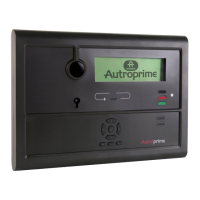
 Loading...
Loading...
Do you have a question about the Autronica Autroprime 2 and is the answer not in the manual?
| Brand | Autronica |
|---|---|
| Model | Autroprime 2 |
| Category | Measuring Instruments |
| Language | English |
Describes the document's purpose and scope regarding site-specific installations.
Identifies the intended audience, assuming familiarity with basic operations.
Lists related technical documentation available for the system.
Explains the system's default state with detectors recognized but not fully configured.
Details the essential steps to save configuration changes and restart the system.
Introduces practical examples for understanding configuration principles.
Outlines typical configuration tasks performed via panel buttons.
Explains the required access level for performing service commands.
Introduces the main service menu and its structure.
Provides step-by-step instructions on how to access the service menu.
Lists all available global system settings accessible from the Service Menu.
Details the process for saving current system configuration settings.
Explains how to restart the system to apply saved configurations.
Configures automatic delays for output activation based on time of day.
Describes how to change the password for accessing service mode.
Provides instructions for setting the system's date and time.
Details the procedure for safely shutting down the system panel.
Resets the system configuration to its original factory defaults.
Guides on how to navigate to and access loop operation menu options.
Describes the process for re-enabling previously disabled detection loops.
Explains how to temporarily disable detection loops for service purposes.
Allows technicians to modify the duration for which loops remain disabled.
Identifies loop units affected by dust pollution above a set limit.
Lists loop units operating at lower current levels than standard.
Lists the main categories for configuring system units.
Configuration of detection zone properties, types, and connections.
Configuration of alarm zone properties and relationships between zones.
Configuration of individual points (detectors, call points) and their properties.
Configuration options for outputs connected to detection loops.
Configuration options for inputs connected to detection loops.
Settings for connecting the system to external communication interfaces.
Configuration of loop parameters like name, current limits, and override settings.
Lists the available functions for testing individual system units.
Procedures for manually testing detection zones and their points.
How to perform a manual test of alarm zones and their devices.
Step-by-step guide to testing individual Fire Alarm Devices (FADs).
Instructions for testing the functionality of loop outputs.
Procedures for testing the operation of local output signals.
Guide for testing the functionality of connected mimic panels.
Lists the available functions for viewing the system's topology.
Displays detailed information about selected loops or panel bus.
Provides a visual representation of the panel bus and loop structure.
Displays detailed fault information related to the panel bus and loops.
Resets a loop's configuration and restarts the system for re-initialization.
Procedure to deactivate a selected detection loop that is not in use.
Procedure to activate a previously deactivated detection loop.
Lists the menu options for exporting and importing system data.
Describes using a USB memory stick for data export and import.
How to export system event logs for analysis.
Restarts the system using a selected configuration file.
Creates an internal backup of the system's current configuration.
Exports the current system configuration to a USB memory stick.
Imports configuration files from a USB device into the system.
Provides initial setup guidance and default system configuration overview.
Demonstrates a step-by-step basic configuration of the system.
Illustrates a more complex configuration with multiple zones and functions.
Utilizes clipboard features for efficient entry of names and text.
Explains how to switch between capital and small letters during text input.
Overview of the PC-based configuration tool for system setup.
Guides the user through the installation process of the configuration tool.
Instructions on how to launch the Autroprime configuration software.
Directs users to detailed information within the tool's help menu.
Explains the system's structure for managing alarm events.
Details the various types of detection zones and their unique properties.
Describes how detection zones control the activation of alarm zones.
Explains detection zones configured for delayed output activation.
Describes zones with delayed actions dependent on multiple inputs.